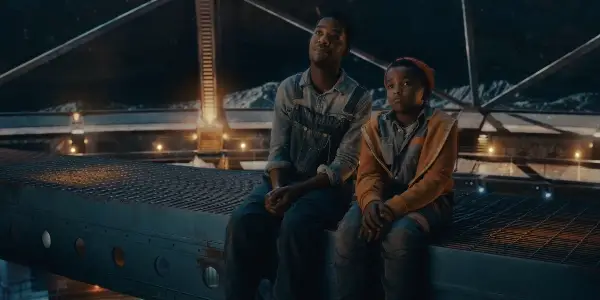
They don’t make movies like Crater anymore. Because when they do, they get poor viewership and mediocre reviews and are scrubbed from Disney+ a month and a half after they premiere.
The most interesting thing about Crater, a milquetoast sci-fi family coming-of-age adventure made by, of all people, The Stanford Prison Experiment director Kyle Patrick Alvarez, is that it was unceremoniously dropped from Disney+ a little over a month after its release. Backlash ensued, for obvious reasons, and the film was rereleased for video-on-demand platforms.
This little blip in the media landscape — a mere footnote in the history of streaming’s impact on (and, in some cases, war on) cinema — is why Crater has any kind of relevance. It’s emblematic of the ways corporate greed stands in the way of art and creative expression. Even bad art and misguided creative expression — Crater isn’t good, by the way. Regardless, I’d rather Disney+ be flooded with a hundred Craters than have them erased from existence the moment they underperform.
The Children Do Not Yearn For The Mines
In Crater, the Moon has been converted into an OSHA-nightmare mining colony. There are no railings anywhere. Kids are allowed to climb hundred-foot ladders unsupervised. Families move to the lunar mines to extract helium to power space voyages to another, better planet, named Omega. Unfortunately, though the miners are promised eventual passage to Omega, the truth is that once on the Moon, they get suckered into 20-year-plus contracts that roll over to their next of kin when they die. As a result, the vibes are a bit like the penal colony of Fury 161 in Alien 3. Plenty of antiquated mining equipment, zero regard for safety, lots of bitter workers, and no apparent community among the people trapped there.
The kids on the Moon, unfortunately, do not yearn for the mines. Dylan (Billy Barratt) is dreading the day he turns 18, because that’s mining age. Old enough to smoke, old enough to mine helium. His friend Caleb (Isaiah Russell-Bailey) gets a one-way ticket off the rock, though: His father (Kid Cudi) Death of a Salesman’s himself to exploit a death clause that’ll send Caleb to Omega when he’s 18. Caleb and Dylan, along with a ragtag group of friends, band together to have one last hurrah before Caleb leaves for good.
source: Disney+
The mission entails stealing a rover and heading to a crater 12 hours away from the mining colony where Caleb’s dad stashed something. Along the way, the kids play some lunar baseball, mess around with oxygen tanks, trash a Moon house, and dodge a meteor shower. It’s like The Goonies if that movie looked like an IKEA showroom instead of dirty worms.
As far as coming-of-age stories go, Crater is suspiciously simple, dressing up a generic, bare-bones plot and a cast of archetypes with sci-fi worldbuilding. To be fair, the worldbuilding — usually a 13-letter word to disguise bad writing — is actually pretty cool. You don’t often see a script about the Moon that also involves discussions of labor rights and the exploitation of the working class. Usually, you get nonsense like that moon rover chase scene in Ad Astra where an astronaut gets shot in the face by a moon pirate and Brad Pitt shoves his corpse out into the lunar bluffs and then drives the rover off a cliff. But aside from the interesting socioeconomics of the story, Crater never says or does anything interesting or challenging. On the level of plot, this thing is as colorless and worthless as a wheelbarrow full of moon rocks. The situations are rote by sci-fi standards and often feel like plot beats from a better coming-of-age movie from the 1980s or 1990s, but this time it’s set in space.
Low Gravity, Lower Stakes
Midway through Crater, my brain itched; the film seemed familiar somehow, and not just because it’s formulaic. It turns out that Crater, written by John Griffin, made the rounds as a Black List script years ago, which is where I first heard of it. The Black List is where unproduced screenplays get kudos and recognition from folks in the industry. Crater was originally slated to be directed by Stranger Things producer and director Shawn Levy, who frankly could’ve filmed this thing in three days and gotten a solid eight hours of sleep between shoots. Instead, Levy and his Stranger Things collaborator Dan Cohen are producers on the final product, and Alvarez directs.
source: Disney+
Crater, it seems, has changed precious little since its Black List days, with no additional co-writers attached to polish it up. All the good low-gravity wirework and impressive visual effects in Crater can’t compensate for that initially weak script: The kids have little motivation and lack dynamic personalities, the characters spend too much time talking about stuff we never see, and Caleb’s core mission is emotionally hollow.
The ill-defined characters are the weakest part of the film. Addison (Mckenna Grace) is a kid from Earth, the abrasive loner scholar of the group whose standoffish personality disappears completely 40 minutes into the movie. After that, she’s a non-character who just exists to tell the other kids how cool Earth is. Grace is an immensely talented performer, and she totally sells a monologue about baseball, but there’s just nothing in Crater to suit her talents. Borney (Orson Hong) is the worrywart of the group, and that’s about all there is to him. Marcus (Thomas Boyce) has an enlarged heart and has to regularly take medication so he doesn’t pass out, which is just the same as all of those coming-of-age movies where the least important kid also has an asthma inhaler just so the audience can remember something about him. And our main duo, Dylan and Caleb, never feel like they have a rapport or a history, which is kind of an issue because we’re supposed to, y’know, care about whether or not their friendship gets broken up.
The stakes, too, are way too low. We’re never told what’s at this mysterious crater — only that Caleb’s dad really wanted him to go there — and while it’s fine for a little mystery in your lunar treasure hunt movie, the script doesn’t compensate for it. The film has to be about something, but Crater puts all its chips on the crater mystery and then coyly refuses to give you any more information about it until the kids arrive there, instead biding its time with space nonsense, low-gravity antics, and long conversations about what Earth is really like, whether the sky is really blue, what wars were fought and when, and why each of the characters are on the Moon in the first place.
Coal Minin’ Might Be Your Life, But It Ain’t Mine
Remember October Sky? The movie about a bunch of kids in a coal-mining town who build rockets? Within October Sky’s first five minutes, each of the principal characters is perfectly defined and feels real, despite that the movie’s a period piece set in a coal-mining town. Jake Gyllenhaal’s character, who has a dumb name that I can’t remember — (I just looked it up, it’s Homer. Apologies to all the Homers out there.) — is wonderfully set up as a dreamer, a kid whose ambition is to become an astronaut. But while his dream might be to leave the atmosphere, his real goal is to just leave Coalwood. But what he needs is acceptance and love from his dad (Chris Cooper). It’s a classic example of an old characterization rule, the “want vs. need” that makes a character’s journey unexpected and engaging. We see the trials he goes through to achieve that escape, including standing up to his coal-miner father, which makes it more satisfying and emotionally resonant when his dad finally puts aside his anxiety over his livelihood so he can support his son. At every turn in the script, October Sky reminds us exactly what Homer wants and how he aims to get it, and in return, the setbacks he faces feel more deflating, and the victories more thrilling. Seeing what makes a script like October Sky work so well helps us to understand the shortcomings of an unsuccessful film like Crater.
source: Disney+
Crater and October Sky are very similar films — both deal with kids living basically in poverty, trapped in a mining town with their only hope of escape lying in the stars. But October Sky has scope, texture, and complex characters, and Crater just doesn’t. Much of that has to do with the directing, which is probably hindered by shooting entirely on blue-screen soundstages. I don’t believe a single set was fully constructed for this movie — it looks sturdy but fake, and the visual effects only get worse for the big set pieces, like the oxygen tank sequence and the meteor shower. I wouldn’t be surprised if there was at least one blue-screen or LED screen element in every set-up. Some scenes feel as though they’re completely shot on an LED volume soundstage. Compare that to October Sky, which is so detailed, grimy, dirty, and vibrant that you can tell it’s shot in a real place. Watching October Sky, I thought about how much dirt Gyllenhaal and Cooper must’ve had to wash out of their hair at the end of a long shoot day. Crater comparatively feels clean, airbrushed, and safe.
Furthermore, the way Crater is shot and directed doesn’t foreground any of the characters. Instead, Addison, Dylan, and Caleb are jockeying for Main Character Status, while common sense dictates that the filmmakers should’ve just picked one of them and stuck to it. Caleb gets all the flashbacks, but Dylan is the only person in the movie who gets an arc, and Addison is the outsider from Earth, so she’s a better audience surrogate. But we don’t commit to any of them, which makes the characters’ goals harder to identify and muddles the narrative.
Emotionally, the script is too conservative. Griffin fixates on the characters’ emotional journeys, though the score from Dan Romer and Olei Essed does most of the heavy lifting. But even with that support from two great composers, Griffin’s story only really deals with blind hope and enthusiasm. There’s none of the emotional depth one expects from the premise. No grief over the potential loss of a friend. No fear of setting out into the unknown. No heartbreak over the loss of Caleb’s parents. It all culminates in a moon-cheese ending that basically just apes that scene from Interstellar where Matthew McConaughey watches decades of video messages from his kids as they grow up without him. The relationships in Interstellar are second to the space adventure story, and in Crater, it’s the opposite, but an hour and 40 minutes of kids bonding on the Moon doesn’t yield anything as emotionally devastating as Cooper sitting in the spaceship, powerless to help his children and grappling with all the time he’s lost.
Conclusion: Crater
At one point, the moon-Goonies pass a defunct lunar paradise, a distant city-of-the-future whose construction has been long abandoned. There are unfinished metal rings around the 1960s skyscrapers, all on a barren grey rock surface against the stark darkness of space. It’s a really impressive visual design, and I’m sure some VFX artists and production designers worked hard on it. Unfortunately, Disney just doesn’t care about labor. There are so many good details in the production design and the visual effects that went unappreciated by the studio. At the end of the day, though, Disney poorly promoted Crater and then dropped it from its streaming service because some exec saw it as a better tax write-off than a piece of content.
Ironically, considering what happened to Crater, the movie is all about failed promises, wasted potential, corporate greed, and the need for unions. Crater might not be a good movie, but the really strong elements of it — some of the design, the worldbuilding with the labor disputes surrounding the helium mine, the earnest performances, and the wonderful score — deserve better than this. Like that decommissioned city on the Moon, Crater is a dream that a corporation gave up on and left to rust out in space.
Crater is available to rent online. It used to be on Disney+.
Does content like this matter to you?
Become a Member and support film journalism. Unlock access to all of Film Inquiry`s great articles. Join a community of like-minded readers who are passionate about cinema – get access to our private members Network, give back to independent filmmakers, and more.




